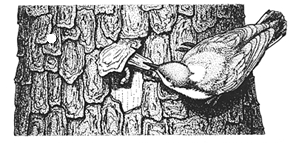|
At one time it was assumed that humans were unique among creatures in their ability to use tools. Now it is clear that tool using is widespread in the animal kingdom. For instance, chimps use twigs to fish termites out of termite mounds, and small wasps use pebbles to tamp down earth over their nests. Birds are no exception -- tool use has been demonstrated in several species. Perhaps the best-known avian tool user is the Woodpecker Finch, one of "Darwin's finches," on the Galapagos Islands. It uses a cactus spine or wooden splinter to dig grubs or other insects out of holes. Although in general the Woodpecker Finch forages much like a true woodpecker, the two birds are unrelated. The woodpecker pries up bark with its bill, uncovering insects underneath and in holes and immediately devours those it can reach. But the finch has not evolved the long tongue that permits real woodpeckers to extract wood-boring insects from their deep holes. When such insects are found, the finch flies to a cactus, breaks off a spine, and returns to spear its prey. If a cactus spine is not available, the Woodpecker Finch may break a twig off a bush or tree, and if necessary even trim it of twiglets. In these cases the bird not only uses a tool, it "manufactures" it. Egyptian Vultures use stones as tools to assault the eggs of ostriches, often throwing rock after rock until an egg is breached and its contents can be consumed. White-winged Choughs, raven-like Australian birds, are reported to employ pieces of mussel shell as hammers in their attempts to open other mussels. Another Australian bird, the Brush Turkey, builds gigantic mounds of soil and decaying vegetation (as much as 36 feet across and 16 feet high) in which to incubate its eggs; the turkey kicks these materials into a pile with its powerful legs. It seems a natural transition for the bird to use debris as a tool (a weapon), by kicking it toward competitors -- large monitor lizards that share their rain-forest habitats and compete for the insects and seeds that compose the turkey's diet. One of the most astonishing examples of the employment of tools by a bird is the use of bait by fishing Striated Herons (Butorides striatus) in southern Japan. The herons obtain bait as diverse as live insects, berries, twigs, and discarded crackers, and cast them on the waters. They then crouch and wait for the curious or hungry fish that comes to inspect the lure. The birds have even been observed carefully trimming oversized twigs to the proper dimensions -- so that like the Woodpecker Finch, the herons actually engage in tool manufacturing. Young herons are less successful bait-fishers than their elders, in part because they tend to use twigs that are too large. While the herons can fish successfully without bait, their use of bait seems to enlarge the catch. You should be on a sharp lookout for similar behavior in North American herons. Green jays in Texas have been observed using twigs to extract food from crevices, and an American Robin is recorded as having used a twig to sweep aside leaves, but the only North American bird to habitually use tools is the Brown-headed Nuthatch. At least in one longleaf pine forest in Louisiana, it employs bits of bark to pry off other bits of bark when it searches for insects. Sometimes several pieces of bark are removed and the exposed area searched before a single bark tool is dropped, and the birds have been observed flying from place to place carrying the tools.
This behavior is most common in years when pine seeds, normally a major item in the nuthatches' diet during the fall and winter, are scarce. Tool use may have evolved from the nuthatches' habit of wedging pine seeds into cracks in the flaky bark of the longleaf pines while they hammer them open. That wedging behavior may have led to the accidental prying off of pieces of bark and the exposure of previously hidden insects. Using flakes of bark roughly the size of the pine seeds to remove other bark flakes may have followed. Interestingly Australian sittellas, which look and behave like nuthatches in many ways, but are not even remotely related to them, also use tools. They dip strips of wood into cavities to evict hiding insects. Finally, it is not unusual to find birds using ants as tools for cleaning or disinfecting their plumage. Additional careful observation of North American birds will probably reveal other examples of tool use and answer several questions about this interesting behavior. Is the use of tools by Brown-headed Nuthatches widespread in longleaf pine forests, or highly localized? Is this the only nuthatch species to use tools, or does the western Pygmy Nuthatch do the same? How about the other nuthatches? Was that "sweeping" robin a one-time fluke, or do other robins (or other birds that forage on the ground) occasionally take up tools? Once you've identified a feeding bird, take the time to observe it and note its behavior. SEE: Anting. Copyright ® 1988 by Paul R. Ehrlich, David S. Dobkin, and Darryl Wheye. |
